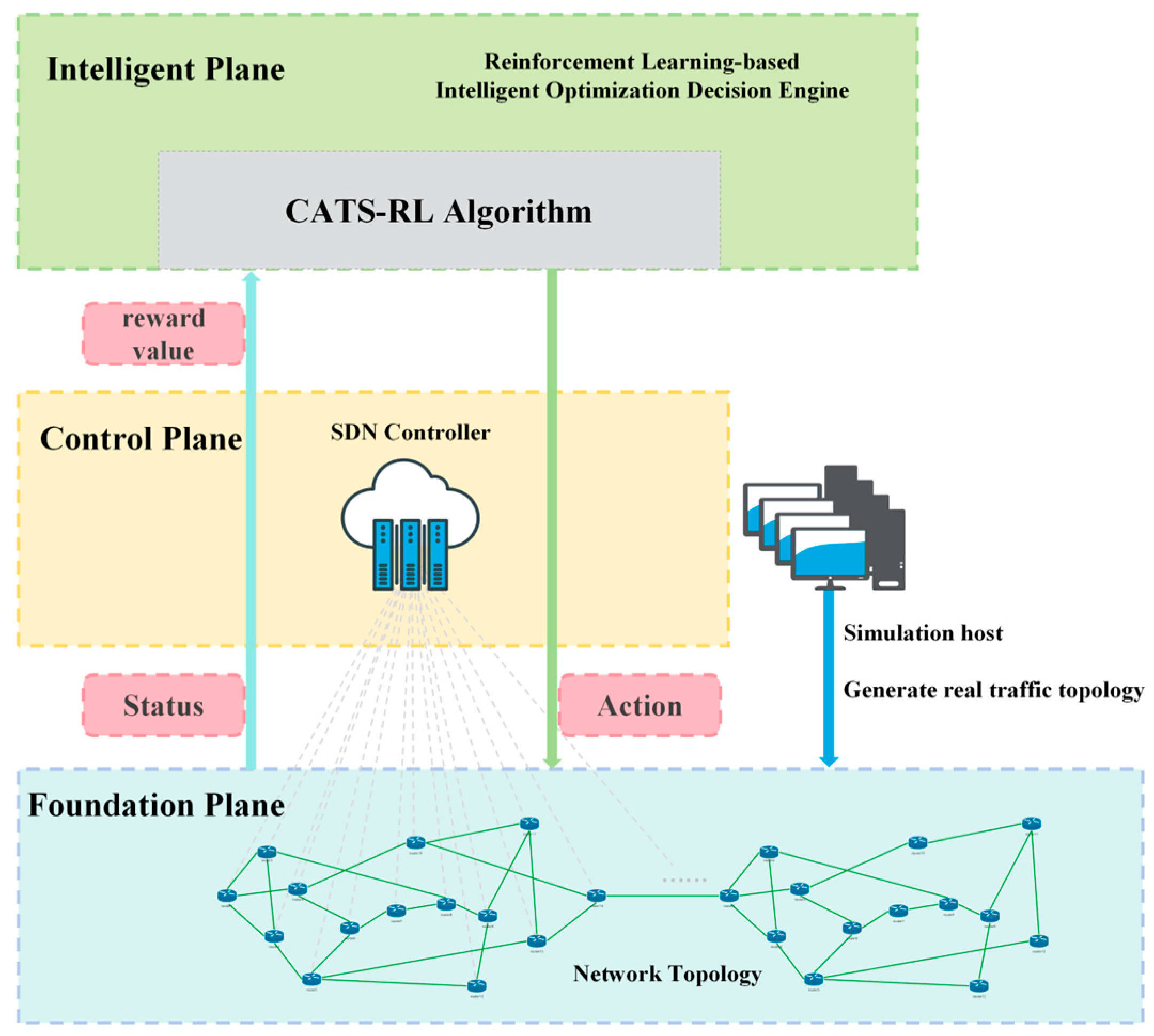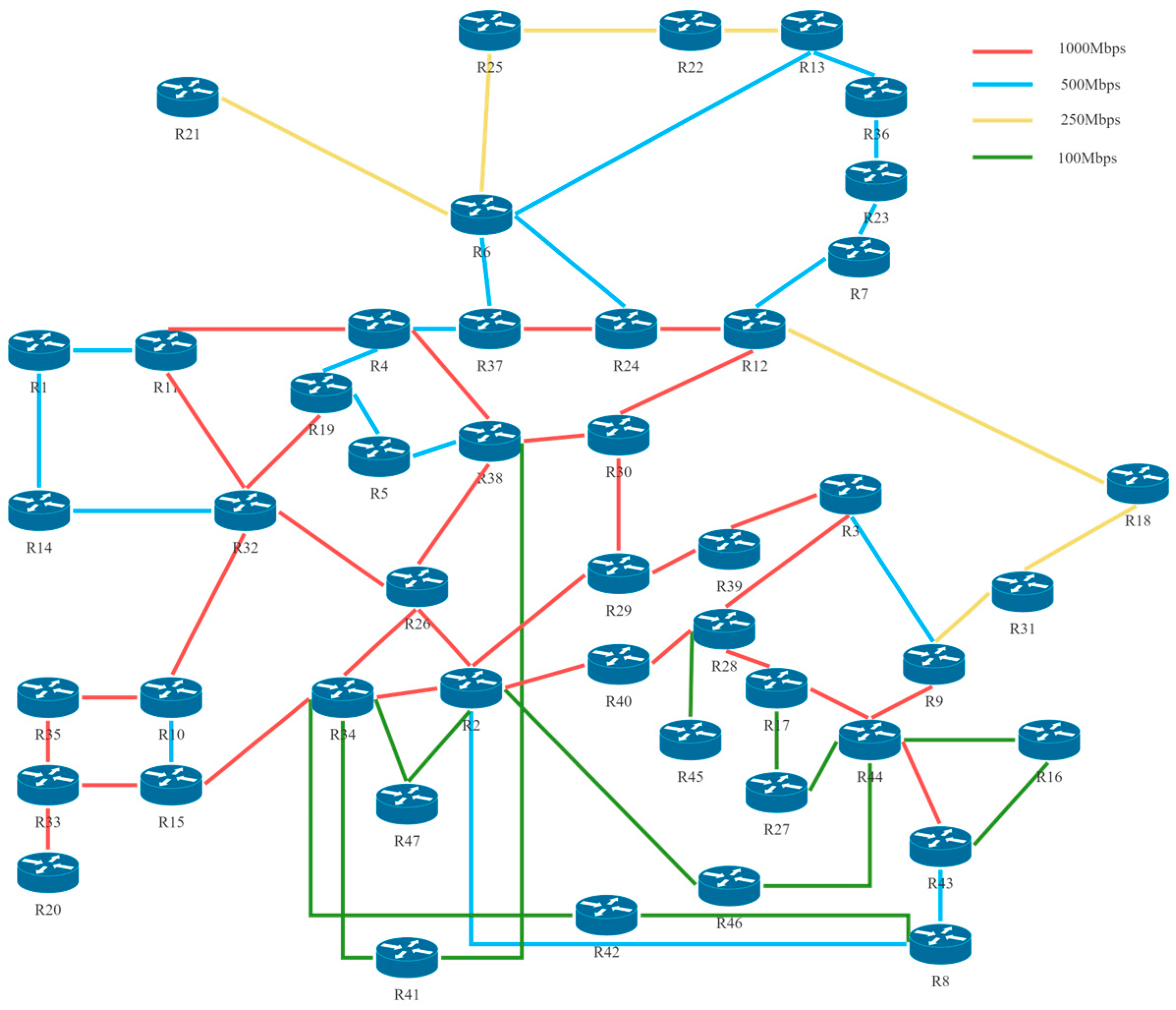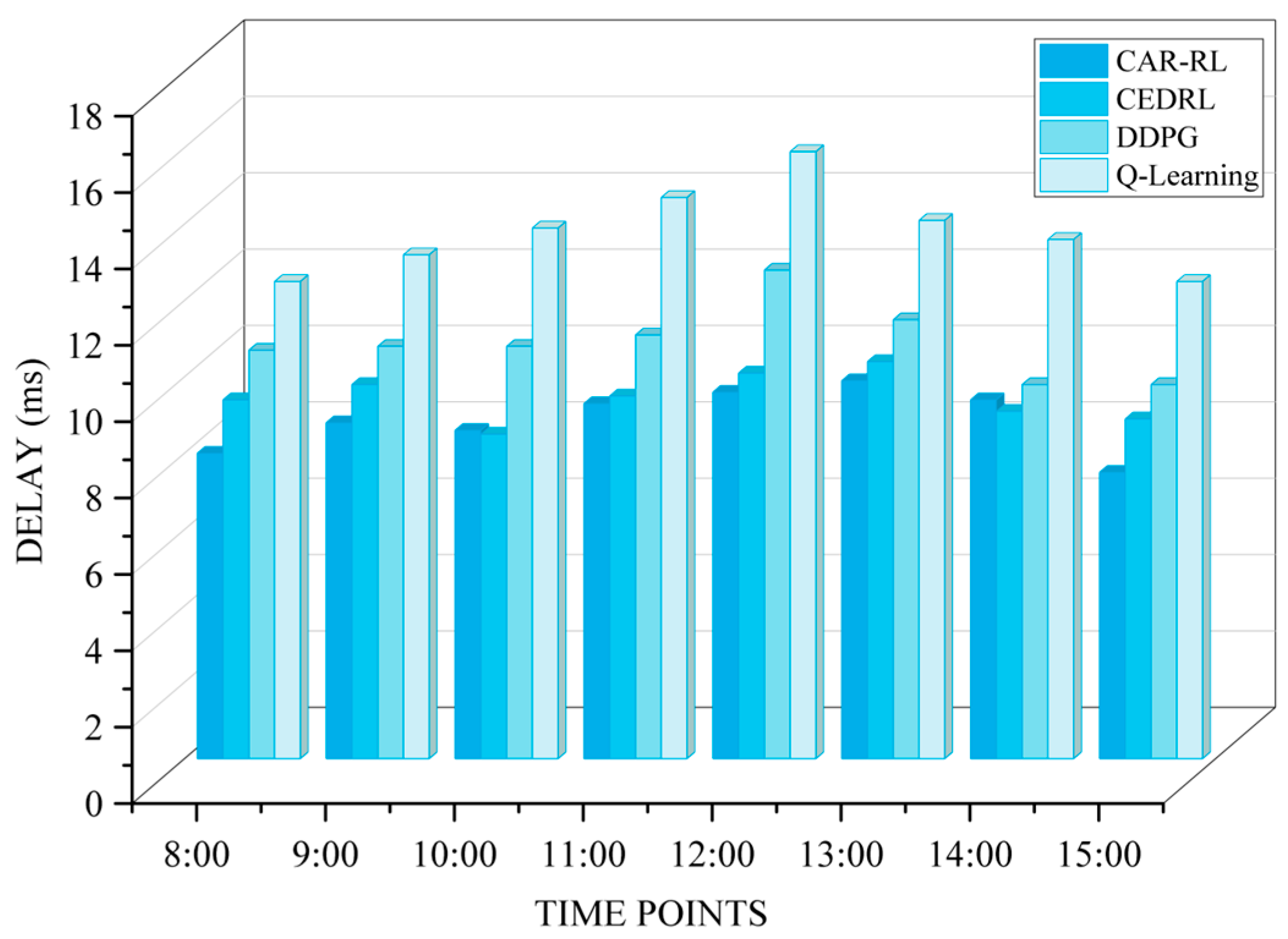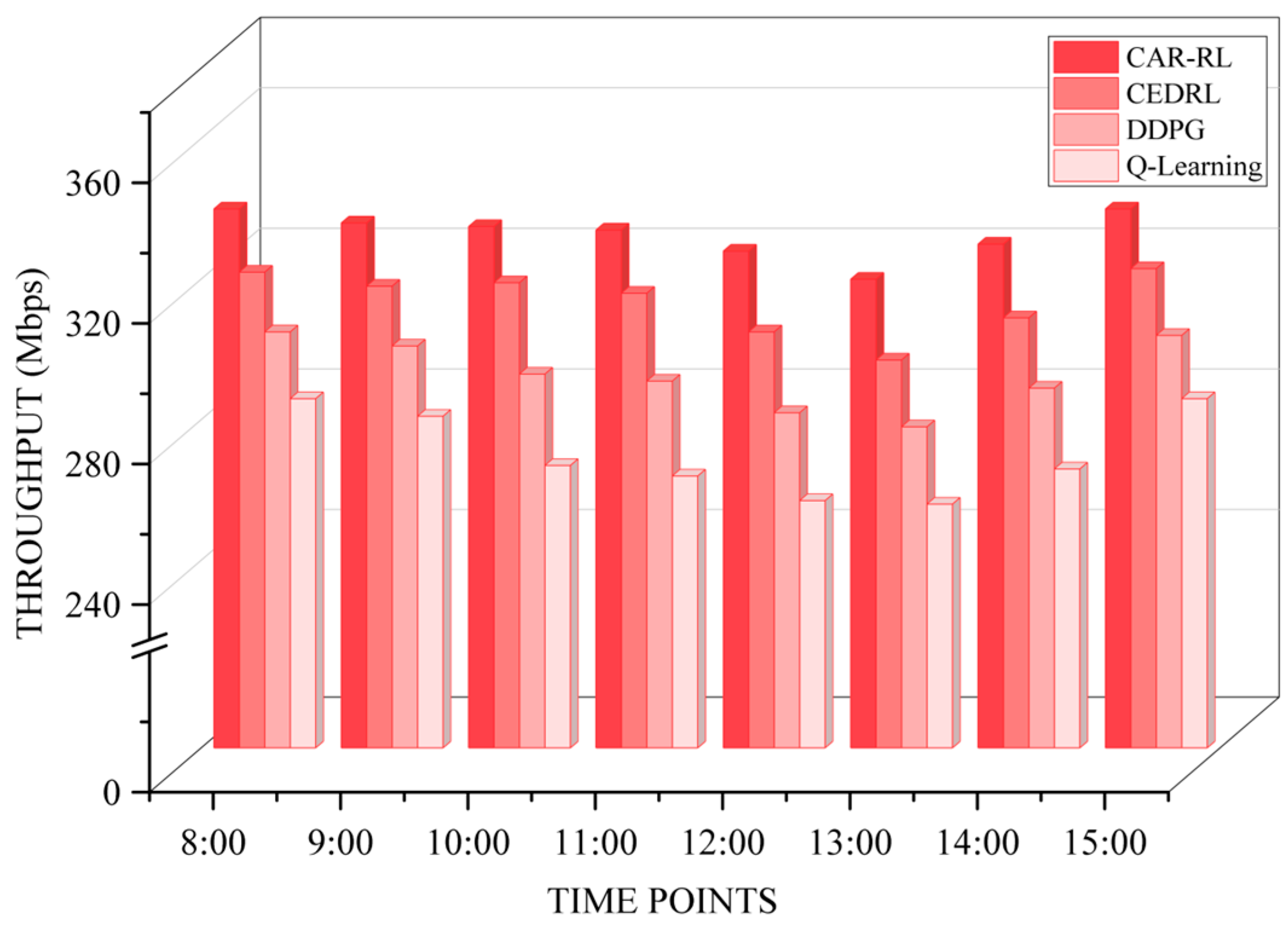A Software-Defined Networking-Based Computing-Aware Routing Path Selection Method
Abstract
1. Introduction
- We propose the CAR-RL algorithm, which integrates network and computing power indicators into the reward function through the Markov decision process (MDP) model to achieve dynamic routing path selection from the source node to the optimal computing power node.
- We introduce the Task-Aware Dynamic Principal Component Analysis (TA-DPCA) computing power measurement method to unify computing power indicators into a comprehensive computing power score, providing accurate computing power cost data for CAR-RL and improving the algorithm’s adaptability.
- We construct a four-layer CAR-RL system architecture, relying on SDN and K8S to provide data input for computing-aware routing, and use it to verify the performance of the CAR-RL algorithm. Simulation experiments based on the Mininet platform show that compared to other algorithms such as Q-Learning, the CAR-RL algorithm improves the average packet loss rate, latency, and throughput by approximately 24.7%, 35.6%, and 23.1%, respectively.
2. Related Work
3. System Design
3.1. CAR-RL System Architecture
3.2. Markov Decision Process Model—Reinforcement Learning-Based Intelligent Optimization Decision Engine
- ①
- With probability ε, where ε ∈ [0,1], randomly select action a∈A(s) to explore new paths.
- ②
- With probability 1 − ε, select the action with the highest Q-value, i.e., select the optimal path using known experience:
4. Computing-Aware Routing Algorithm
4.1. Computing Power Measurement
4.2. Q-Learning-Based Computing-Aware Routing Algorithm
| Algorithm 1: CAR-RL | |
| input:SDN topology G(V, E), computing nodes J ⊆ V, | |
| real-time telemetry (D_net, L_net, BW_net, X_j^CPU, X_j^Mem, X_j^Sto) | |
| output:best_path P*, optimal node j*, Packet Loss, Latency, Throughput | |
| initialize Q_table[s, a; θ] | |
| 1: | FOR episode = 1 to MaxEpisodes do |
| 2: | src ← random node; dst ← random node in J |
| 3: | current ← src; path ← [src]; steps ← 0 |
| 4: | WHILE current_node != dst and steps < MaxSteps do |
| 5: | state ← (current_node, global_load_profile) |
| 6: | IF random() < ε THEN |
| 7: | next_node ← random neighbor of current_node |
| 8: | ELSE |
| 9: | next_node ← arg max_a Q(state, a; θ) |
| 10: | END IF |
| 11: | D_net^*(i,j), L_net^*(i,j), BW_net^*(i,j)←Ryu controller |
| 12: | Cost_net^*(i,j) = α*1/BW_net^*(i,j) + β*D_net^*(i,j) + (1 − α − β)*L_net^*(i,j) |
| 13: | IF next_node == dst THEN |
| 14: | S_j^CPU*, S_j^Mem*, S_j^Sto*←TA-DPCA(X_j) |
| 15: | Cost_comp^*(j) = δ*1/S_j^CPU* + η*1/S_j^Mem* + (1 − δ − η)*1/S_j^Sto* |
| 16: | ELSE |
| 17: | Cost_comp^*(j) = 0 |
| 18: | END IF |
| 19: | metric^*_{(i,j)}←w1*Cost_net^*(i,j) + (1 − w1)*Cost_comp^*(j) |
| 20: | R_t =−metric^*_{(i,j)} |
| 21: | IF next_node == dst THEN |
| 22: | target = R_t |
| 23: | ELSE |
| 24: | target = R_t + γ max_{a’} Q(s_{t + 1}, a’; θ) |
| 25: | END IF |
| 26: | Q(state, next_node)←Q(state, next_node) + α [target − Q(state, next_node)] |
| 27: | current_node ← next_node; path.append(next_node);steps←steps + 1 |
| 28: | END WHILE |
| 29: | END FOR |
| 30: | return best_path P*, optimal node j*, Packet Loss, Latency, Throughput |
5. Experiments and Results
5.1. Experimental Environment Configuration
5.2. Experimental Results Analysis
6. Conclusions and Outlook
Author Contributions
Funding
Data Availability Statement
Acknowledgments
Conflicts of Interest
References
- China Mobile Communications Corporation. White Paper on Computing-Aware Network Technology; China Mobile Communications Corporation: Beijing, China, 2022. [Google Scholar]
- Okonkwo, I.J.; Douglas, I. Comparative study of EIGRP and OSPF protocols based on network convergence. Int. J. Adv. Comput. Sci. Appl. 2020, 11. [Google Scholar] [CrossRef]
- Wumian, W.; Saha, S.; Haque, A.; Sidebottom, G. Intelligent routing algorithm over SDN: Reusable reinforcement learning approach. arXiv 2024, arXiv:2409.15226. [Google Scholar] [CrossRef]
- China Mobile Communications Corporation. Computing-Aware Network White Paper; China Mobile Communications Corporation: Beijing, China, 2021. [Google Scholar]
- China Mobile Research Institute. White Paper on Integrated Network Architecture and Technology System Outlook for Computing-Aware Network; China Mobile Research Institute: Beijing, China, 2022. [Google Scholar]
- Masoudi, R.; Ghaffari, A. Software defined networks: A survey. J. Netw. Comput. Appl. 2016, 67, 1–25. [Google Scholar] [CrossRef]
- Boutaba, R.; Salahuddin, M.A.; Limam, N.; Ayoubi, S.; Shahriar, N.; Estrada-Solano, F.; Caicedo, O.M. A comprehensive survey on machine learning for networking: Evolution, applications and research opportunities. J. Internet Serv. Appl. 2018, 9, 16. [Google Scholar] [CrossRef]
- Mammeri, Z. Reinforcement learning based routing in networks: Review and classification of approaches. IEEE Access 2019, 7, 55916–55950. [Google Scholar] [CrossRef]
- Addula, S.R.; Tyagi, A.K. Future of computer vision and industrial robotics in smart manufacturing. In Artificial Intelligence-Enabled Digital Twin for Smart Manufacturing; Tyagi, A.K., Tiwari, S., Arumugam, S.K., Sharma, A.K., Eds.; John Wiley & Sons: Hoboken, NJ, USA, 2024; pp. 505–539. [Google Scholar]
- Tyagi, A.K.; Tiwari, S.; Arumugam, S.K.; Sharma, A.K. (Eds.) Artificial Intelligence-Enabled Digital Twin for Smart Manufacturing; John Wiley & Sons: Hoboken, NJ, USA, 2024. [Google Scholar]
- Prabu, U.; Ch, S.; Panda, S.K.; Geetha, V. An enhanced dynamic multi-path routing algorithm for software defined networks. Procedia Comput. Sci. 2024, 233, 12–21. [Google Scholar] [CrossRef]
- Gunavathie, M.A.; Umamaheswari, S. Traffic-aware optimal routing in software defined networks by predicting traffic using neural network. Expert Syst. Appl. 2024, 239, 122415. [Google Scholar] [CrossRef]
- Wang, Z.H.; Xi, H.L.; Xu, M.Z.; Liu, X.; Pan, N.; Xiao, Z. A review of intra-domain routing algorithms. Radio Eng. 2022, 52, 1755–1764. [Google Scholar]
- He, Q.; Wang, Y.; Wang, X.; Xu, W.; Li, F.; Yang, K.; Ma, L. Routing optimisation with deep reinforcement learning in knowledge-defined networking. IEEE Trans. Mob. Comput. 2023, 23, 1444–1455. [Google Scholar] [CrossRef]
- Fu, Q.; Sun, E.; Meng, K.; Li, M.; Zhang, Y. Deep Q-learning for routing schemes in SDN-based data centre networks. IEEE Access 2020, 8, 103491–103499. [Google Scholar] [CrossRef]
- Casas-Velasco, D.M.; Caicedo Rendon, O.M.; da Fonseca, N.L.S. DRSIR: A deep reinforcement learning approach for routing in software-defined networks. IEEE Trans. Netw. Serv. Manag. 2021, 19, 4807–4820. [Google Scholar] [CrossRef]
- Chen, X.; Huang, G.P. Computing-aware routing technique under microservice architecture. ZTE Technol. 2022, 28, 70–74. [Google Scholar]
- Zhao, C.; Ye, M.; Xue, X.; Lv, J.; Jiang, Q.; Wang, Y. DRL-M4MR: An intelligent multicast routing approach based on DQN deep reinforcement learning in SDN. arXiv 2022, arXiv:2208.00383. [Google Scholar] [CrossRef]
- Ye, M.; Zhao, C.; Wen, P.; Wang, Y.; Wang, X.; Qiu, H. DHRL-FNMR: An Intelligent Multicast Routing Approach Based on Deep Hierarchical Reinforcement Learning in SDN[A/OL]. arXiv 2023, arXiv:2305.19077. [Google Scholar] [CrossRef]
- Sun, G.W.; Xu, F.M.; Zhu, J.Y.; Zhang, H.; Zhao, C. Deterministic scheduling and routing joint intelligent optimisation scheme in computing-aware networks. J. Beijing Univ. Posts Telecommun. 2023, 46, 9–14. [Google Scholar]
- Jinesh, N.; Shinde, S.; Narayan, D.G. Deep reinforcement learning-based QoS aware routing in software defined networks. In Proceedings of the 14th International Conference on Computing Communication and Networking Technologies (ICCCNT), Delhi, India, 6–8 July 2023; IEEE: New York, NY, USA, 2023; pp. 1–6. [Google Scholar]
- Wang, J.; Zhou, T.; Liu, Z.; Zhu, J. An intelligent routing approach for SDN based on improved DuelingDQN algorithm. In Proceedings of the 9th International Conference on Computer and Communications (ICCC), Chengdu, China, 8–11 December 2023; IEEE: New York, NY, USA, 2023; pp. 46–52. [Google Scholar]
- Zhang, Y.; Qiu, L.; Xu, Y.; Wang, X.; Wang, S.; Paul, A.; Wu, Z. Multi-path routing algorithm based on deep reinforcement learning for SDN. Appl. Sci. 2023, 13, 12520. [Google Scholar] [CrossRef]
- Ye, M.; Huang, L.Q.; Wang, X.L.; Wang, Y.; Jiang, Q.X.; Qiu, H.B. A novel intelligent cross-domain routing method in SDN based on a proposed multi-agent reinforcement learning algorithm. arXiv 2023, arXiv:2303.07572. [Google Scholar]
- Giri, A.; Ujwal, C.; Siri, H.V.; Rakish, A. Reinforcement learning employing a multi-objective reward function for SDN routing optimisation. In Proceedings of the International Conference on Evolutionary Algorithms and Soft Computing Techniques (EASCT), Bengaluru, India, 20–21 October 2023; IEEE: New York, NY, USA, 2023; pp. 1–8. [Google Scholar]
- Liu, W.X.; Cai, J.; Chen, Q.C.; Wang, Y. DRL-R: Deep reinforcement learning approach for intelligent routing in software-defined data-centre networks. J. Netw. Comput. Appl. 2021, 177, 102865. [Google Scholar] [CrossRef]
- Yao, H.; Duan, X.; Fu, Y. A computing-aware routing protocol for Computing Force Network. In Proceedings of the 2022 International Conference on Service Science (ICSS), Zhuhai, China, 13–15 May 2022. [Google Scholar]
- Ye, M. An Intelligent SDWN Routing Algorithm Based on Network Situational Awareness and Deep Reinforcement Learning. arXiv 2023, arXiv:2305.10441. [Google Scholar] [CrossRef]
- Ye, M. Intelligent multicast routing method based on multi-agent deep reinforcement learning in SDWN. arXiv 2023, arXiv:2305.10440. [Google Scholar] [CrossRef]
- Chen, Z.; Zhang, S.; Tang, Y.; Ye, M.; Huo, W. Optimisation of Computing Power Network Routing Strategies Based on Multi-Agent Soft Actor-Critic; IEEE: New York, NY, USA, 2024. [Google Scholar]
- Ma, G.; Ren, Y.; Qiu, Z.; Wu, J.; Wang, J. A Routing Algorithm for Computing Power Networks Based on Deep Reinforcement Learning and Graph Neural Networks. In Proceedings of the 2024 IEEE International Conference on High Performance Computing and Communications (HPCC), Wuhan, China, 13–15 December 2024. [Google Scholar]
- Yassin, G.F.; Abdulqader, A.H. An Intelligent Q-Learning-Based Routing Model. Int. Res. J. Innov. Eng. Technol. 2025, 9, 58–68. [Google Scholar] [CrossRef]
- Tang, Q.; Zhang, R.; Chen, T.; Huang, T.; Feng, L. CaRCS: Joint Optimisation of Computing-Aware Routing and Collaborative Scheduling in Computing Power Networks. IEEE Netw. 2025. [Google Scholar] [CrossRef]
- Mestres, A.; Rodriguez-Natal, A.; Carner, J.; Barlet-Ros, P.; Alarcón, E.; Solé, M.; Muntés-Mulero, V.; Meyer, D.; Barkai, S.; Hibbett, M.J.; et al. Knowledge-defined networking. ACM SIGCOMM Comput. Commun. Rev. 2017, 47, 2–10. [Google Scholar] [CrossRef]
- Biradar, A.G. A comparative study on routing protocols: RIP, OSPF and EIGRP and their analysis using GNS-3. In Proceedings of the 5th IEEE International Conference on Recent Advances and Innovations in Engineering (ICRAIE), Jaipur, India, 1–3 December 2020; IEEE: New York, NY, USA, 2020; pp. 1–5. [Google Scholar]
- Allochio, C.; Campanella, M.; Chown, T.; Golub, I.; Jeannin, X.; Loui, F.; Myyry, J.; Parniewicz, D.; Savi, R.P.; Szewczyk, T.; et al. Deliverable D6.5: Network Technology Evolution Report; European Commission: Brussels, Belgium, 2021. [Google Scholar]







| References | Year | Algorithm Name | Advantages | Disadvantages |
|---|---|---|---|---|
| Fu et al. [15] | 2020 | DQL | Application of DQL to SDN Data Centre Networks | The use of a fat tree topology is rather simplistic |
| Liu et al. [26] | 2021 | DDPG | Continuous action space enables smooth adjustment of link weights | Experiments employed a single topology type |
| Casas et al. [16] | 2021 | DRSIR | Proposed DRSIR, an SDN routing method based on deep reinforcement learning | The reward function did not incorporate the node’s computing power status information. |
| Yao et al. [27] | 2022 | CARP | Proposes a computation-aware routing protocol, CARP | Cost weighting cannot adapt to the load |
| Wang et al. [22] | 2023 | DRL-PD | Proposes an intelligent routing algorithm based on DuelingDQN | State space not reduced in dimension, resulting in slower training for large topologies |
| Ye et al. [28] | 2023 | DRL-PPONSA | Incorporates a traffic prediction module to alleviate congestion | Fails to adapt well to sudden changes in computing power |
| Giri et al. [25] | 2023 | Multi-objective RL | The reward function simultaneously optimises latency and bandwidth | The weighting of objectives failed to enable autonomous exploration |
| Ma et al. [31] | 2024 | GAQN | Graph convolutions automatically capture topological features | Modelling of heterogeneous hardware affinity still has room for improvement |
| Yassin et al. [32] | 2025 | Q-Learning | Q-table implementation is the simplest | Does not account for computing power resource status |
| Tang et al. [33] | 2025 | CEDRL | Joint optimisation of routing and scheduling | Topology expansion leads to slower convergence |
| Our research | 2025 | CAR-RL | Selects optimal computing-aware routing paths by real-time perception of network traffic and computing power status | - |
| Symbol | Description |
|---|---|
| (i,j) | Link (i,j) |
| Delay of link (i,j) | |
| Packet loss rate of link (i,j) | |
| Link available bandwidth of link (i,j) | |
| CPU utilisation of node j | |
| Memory utilisation of node j | |
| Storage capacity utilisation of node j | |
| CPU metric score of node j | |
| Memory metric score of node j | |
| Storage capacity metrics score for node j | |
| Network cost for link (i,j) | |
| computing power cost of link (i,j) | |
| Total cost of link (i,j) |
| NAME | STATUS | ROLES | AGE | VERSION |
|---|---|---|---|---|
| master | Ready | master | 116 d | V1.19.16 |
| node-1 | Ready | node | 116 d | V1.19.16 |
| node-2 | Ready | node | 116 d | V1.19.16 |
| node-3 | Ready | node | 116 d | V1.19.16 |
| node-4 | Ready | node | 116 d | V1.19.16 |
| node-5 | Ready | node | 116 d | V1.19.16 |
Disclaimer/Publisher’s Note: The statements, opinions and data contained in all publications are solely those of the individual author(s) and contributor(s) and not of MDPI and/or the editor(s). MDPI and/or the editor(s) disclaim responsibility for any injury to people or property resulting from any ideas, methods, instructions or products referred to in the content. |
© 2025 by the authors. Licensee MDPI, Basel, Switzerland. This article is an open access article distributed under the terms and conditions of the Creative Commons Attribution (CC BY) license (https://creativecommons.org/licenses/by/4.0/).
Share and Cite
Lv, C.; Cao, X.; Li, J.; Wang, J. A Software-Defined Networking-Based Computing-Aware Routing Path Selection Method. Electronics 2025, 14, 4418. https://doi.org/10.3390/electronics14224418
Lv C, Cao X, Li J, Wang J. A Software-Defined Networking-Based Computing-Aware Routing Path Selection Method. Electronics. 2025; 14(22):4418. https://doi.org/10.3390/electronics14224418
Chicago/Turabian StyleLv, Chang, Xianzhi Cao, Jiali Li, and Jian Wang. 2025. "A Software-Defined Networking-Based Computing-Aware Routing Path Selection Method" Electronics 14, no. 22: 4418. https://doi.org/10.3390/electronics14224418
APA StyleLv, C., Cao, X., Li, J., & Wang, J. (2025). A Software-Defined Networking-Based Computing-Aware Routing Path Selection Method. Electronics, 14(22), 4418. https://doi.org/10.3390/electronics14224418










